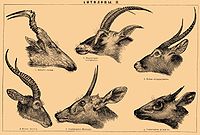- Wastebasket taxon
-
Wastebasket taxon (also called a wastebin taxon,[citation needed] dustbin taxon[1] or catch-all taxon[2]) is a term used in some taxonomic circles to refer to a taxon that has the sole purpose of classifying organisms that do not fit anywhere else. They are typically defined by their lack of one or more distinct character states or by their not belonging to one or more other taxa. Wastebasket taxa are by definition either paraphyletic or polyphyletic, and are therefore not considered to be valid taxa under strict cladistic rules of taxonomy. The name of a wastebasket taxon may in some cases be retained as the designation of an evolutionary grade, however.
The familiar category of invertebrates is an "everything-else" category, comprising all animals without backbones. Other examples of wastebasket taxa include the Protista, Carnosauria, Thecodontia, Palaeoptera and Tricholomataceae. Fossil groups that are poorly known due to fragmentary remains are sometimes grouped together on gross morphology or stratigraphy, only later to be found to be wastebasket taxa, such as the more or less crocodile like Triassic group Rauisuchia.[3] Sometimes, during taxonomic revisions, the wastebasket taxa can be salvaged after doing thorough research on its members, and then imposing tighter restrictions on what continues to be included. Such techniques "saved" Carnosauria and Megalosaurus. Other times, the taxonomic name contains too much unrelated "baggage" to be successfully salvaged. As such, it is usually dumped in favour of a new, more restrictive name (for example, Rhynchocephalia or Thecodontia), or abandoned altogether (for example, Simia).
A related concept is that of form taxon, "wastebasket" groupings that are united by gross morphology. This is often result of a common mode of life, often one that is generalist, leading to generally similar body shapes by convergent evolution.
See also
References
- ^ Hallam, A.; Wignall, P. B. (1997). Mass extinctions and their aftermath. Oxford [England]: Oxford University Press. p. 107. ISBN 978-0-19-854916-1. http://books.google.com/?id=06yrErJt_NsC&lpg=PA107&dq=%22dustbin%20taxon%22&pg=PA107.
- ^ Monks, N. (2002). "Cladistic analysis of a problematic ammonite group: the Hamitidae (Cretaceous, Albian-Turonian) and proposals for new cladistic terms". Palaeontology 45 (4): 689–707. doi:10.1111/1475-4983.00255.
- ^ Nesbitt, S. J. (2003). "Arizonasaurus and its implications for archosaur divergence". Proceedings of the Royal Society B 270 (Suppl. 2): S234–S237. doi:10.1098/rsbl.2003.0066. PMC 1809943. PMID 14667392. http://www.journals.royalsoc.ac.uk/content/2vetg3w8xha9e992.
Categories:- Scientific classification
- Taxonomy
Wikimedia Foundation. 2010.

